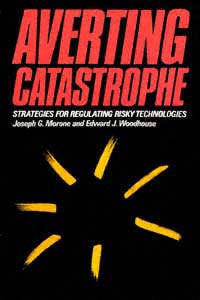Morone, Joseph G. and Edward J. Woodhouse. Averting Catastrophe: Strategies for Regulating Risky Technologies (University of California Press, 1986)
 In their book Morone and Woodhouse seek to explain how some organizations manage to avoid accidents even though they work in areas with some of the most potentially catastrophic failures. Their analysis produces what they call a catastrophe-aversion system, which has certain implementable elements that can help prevent disasters. The authors examine five different areas: toxic chemicals, nuclear power, recombinant DNA, ozone layer threat, and greenhouse gas effects.[1]
In their book Morone and Woodhouse seek to explain how some organizations manage to avoid accidents even though they work in areas with some of the most potentially catastrophic failures. Their analysis produces what they call a catastrophe-aversion system, which has certain implementable elements that can help prevent disasters. The authors examine five different areas: toxic chemicals, nuclear power, recombinant DNA, ozone layer threat, and greenhouse gas effects.[1]
Morone and Woodhouse argue that there are five strategies that a technological system can adopt to avert disasters. The first is for an organization to take steps to protect against the worst possible accident. There are four ways to do this: prohibit use altogether, limit use, prevention, and containment or mitigation. The second strategy is for organizations to proceed carefully with hazardous aspects of certain technologies. The third strategy calls for reducing the risk by running simulation of potential hazards under controlled conditions (130). Another way to reduce risk was to learn from experience, which the authors say is the fourth strategy (132). On this fourth strategy, Morone and Woodhouse specifically mention the nuclear industry. They write, “The history of nuclear regulation is replete with examples of trial-and-error learning. Many changes in the regulations governing operator training, design of reactor control panels, operation, maintenance, and emergency procedures evolved in response to the lessons learned from the Three Mile Island accident” (132). Finally the fifth strategy is to set priorities in implementing the third and the fourth strategy (134-135).
The authors stress that none of the five different areas of risky technologies they closely analyze “has completely followed this idealized system,” suggesting that if a government, regulatory institutions, and related organizations followed to these five strategies are, they can most likely avert catastrophic disasters (135).
Morone and Woodhouse’s work supports what is known as the High Reliability Organizations Theory (HRT), which argues that there are some organizations that are complex, tightly coupled and pose high hazard, but that have “a very low error rate and an almost total absence of catastrophic failure.”[2] In the mid 1980s, HRT was one of the two competing organizational theories of accidents. The other theory, referred to as the Normal Accidents Theory, was put forth by Charles Perrow.
Averting Catastrophe is divided into eight chapters. Chapter one introduces the study. Chapters two through six specifically address the five areas listed above. Chapter seven lays out the strategies toward building a catastrophic-aversion system, and chapter eight concludes the study. For pedagogical purposes, an instructor can assign chapter one and chapter seven to introduce the books’ concepts to students. An instructor can pick one of the five middle chapters to present any one of the case studies in detail. This book is suitable for both undergraduate and graduate level seminars.
Anto Moshin, Science and Technology Studies, Cornell University.
—
[1] This study was published in 1986, the year the Chernobyl disaster occurred. Consequently, the authors do not mention anything about Chernobyl in their book, although they do address the Three Mile Island accident.
[2] Todd R. La Porte and Paula M. Consolini. 1991. “Working in practice but not in theory: theoretical challenges of high-reliability organizations.” Journal Public Administration Research and Theory, p. 21.
![[Teach311 + COVID-19] Collective](https://blogs.ntu.edu.sg/teach311/files/2020/04/Banner.jpg)